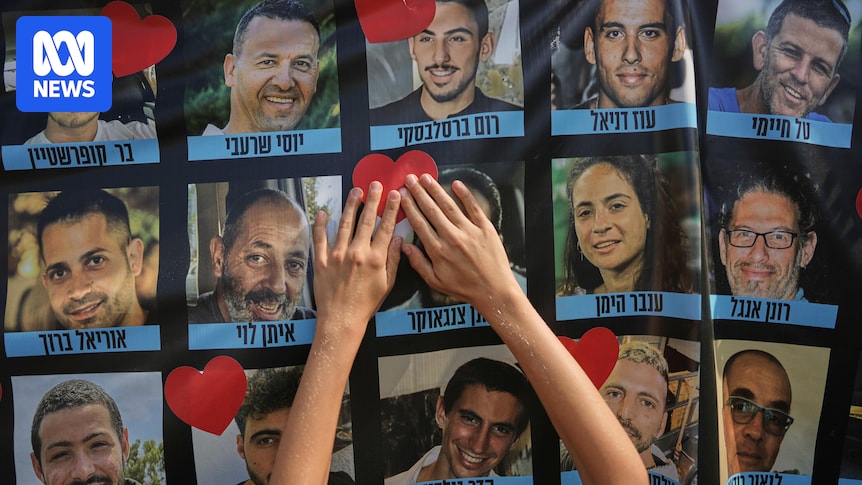US President Donald Trump has unilaterally declared that phase two of the Gaza ceasefire has begun, as the remains of four deceased hostages are expected to be returned to Israel in the coming hours.
The Israel Defense Forces (IDF) said the International Committee of the Red Cross (ICRC) was “on its way to the meeting point in the southern Gaza Strip, where several coffins of deceased hostages” would be “transferred into their custody”.
Hamas had earlier informed mediators it would begin transferring the bodies at 10pm, local time, on Tuesday (6am AEDT on Wednesday), an official involved in the operation told Reuters.
In a post on his social media platform, Mr Trump said the 20 hostages released on Monday were “feeling as good as can be expected”.
“A big burden has been lifted, but the job is not done. The dead have not been returned, as promised!” he said.
“Phase two begins right now!”
Israeli officials said the Rafah border crossing between Gaza and Egypt would stay closed, at least through Wednesday, and the flow of aid into the Palestinian enclave would be reduced to put pressure on the militant group to hand over the remaining bodies of the hostages.
Israel has slowed shipments of aid into Gaza as it awaits the release of the remains of deceased hostages. (Reuters)
On Monday, the last 20 live hostages were released from captivity and the bodies of only four dead hostages were handed over.
In exchange, nearly 2,000 Palestinian detainees and prisoners were released by Israel.
The Israeli military said the four bodies had been identified — one of them was a Nepalese student.
This leaves 23 hostages in Gaza formally declared dead, plus one whose fate is undetermined.
Some families fear their loved ones’ remains will be lost forever in the rubble of Gaza.
A special international task force is meant to help locate bodies that Hamas is not able to find.
The families of hostages accused Hamas of reneging on the deal, which stipulated it must hand over all remaining hostages, dead or alive, within 72 hours of the ceasefire starting at midday on Monday.
The militant group said locating the bodies would be difficult due to the rubble, a caveat already acknowledged by Mr Trump, who steered the ceasefire deal.
Some reports also suggest Israel informed hostage families months ago that it could be difficult to recover the bodies.
Crowds in the Gaza city of Khan Younis greeted Palestinian prisoners released by Israel as part of the ceasefire agreement. (Reuters: Abdel Kareem Hana)
Palestinians killed, aid hindered
The ceasefire has held since the exchange, except for the Israeli military killing six Palestinians.
Although Israeli troops withdrew from urban areas in Gaza under the ceasefire that began last week, drone fire killed five people as they went to check on houses in a suburb east of Gaza City and an air strike killed one person and injured another near Khan Younis, Gaza health authorities said.
The IDF said it opened fire on Tuesday to remove a “threat” posed by “suspects” who approached its forces in the northern Gaza Strip.
It said they had crossed truce lines and approached its forces after ignoring calls to turn back, in a violation of the deal.
Hamas accused Israel of violating the ceasefire.
Parts of Gaza have been entirely destroyed amid two years of fighting between Israel and Hamas. (Reuters: Dawoud Abu Alkas)
Aid trucks have yet to be permitted to enter Gaza at the full anticipated rate of hundreds per day, and plans have yet to be implemented to open the crossing to Egypt to let some Gazans out, initially to evacuate the wounded for medical treatment.
Israel has told the United Nations it will only allow 300 aid trucks — half the agreed number — into the Gaza Strip from Wednesday and that no fuel or gas will be allowed into the enclave except for specific needs related to humanitarian infrastructure, according to a note seen by Reuters and confirmed by the UN.
UN Office for the Coordination of Humanitarian Affairs in Gaza spokesperson Olga Cherevko confirmed the UN had received the note from COGAT, the arm of the Israeli military that oversees aid flows into Gaza.
COGAT had said on Friday that it expected about 600 aid trucks to enter Gaza daily during the ceasefire.
The COGAT note said the restriction had been put in place because “Hamas violated the agreement regarding the release of the bodies of the hostages”.
Hamas retaking control
Meanwhile, Hamas has swiftly reclaimed the streets of Gaza’s urban areas, following the partial withdrawal of Israeli troops last week.
In a video circulated late on Monday, Hamas fighters dragged seven men with their hands tied behind their backs into a Gaza City square, forced them to their knees and shot them from behind, as dozens of onlookers watched from nearby shopfronts.
A Hamas source confirmed that the video was filmed on Monday and that Hamas fighters participated in the executions. Reuters was able to confirm the location by visible geographic features.
Mr Trump has given his blessing to Hamas to reassert some control of Gaza, at least temporarily.
Israeli officials, who say any final settlement must permanently disarm Hamas, have so far refrained from commenting publicly on the re-emergence of the group’s fighters.
Gaza residents said fighters were increasingly visible on Tuesday, deploying along routes needed for aid deliveries. Palestinian security sources said dozens of people had been killed in clashes between Hamas fighters and rivals in recent days.
A summit co-hosted by Mr Trump in Egypt on Monday ended with no public announcement of major progress towards establishing an international military force for Gaza, or a new governing body.
The ABC understands low-level background talks are ongoing.
ABC/Reuters

